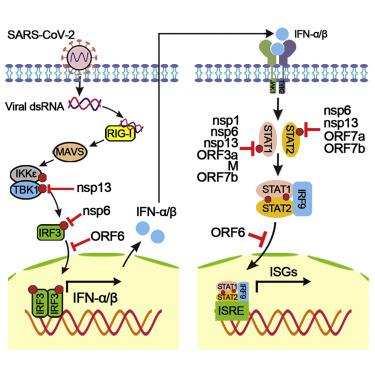Cell Reports ( IF 7.5 ) Pub Date : 2020-09-19 , DOI: 10.1016/j.celrep.2020.108234 Hongjie Xia 1 , Zengguo Cao 2 , Xuping Xie 1 , Xianwen Zhang 1 , John Yun-Chung Chen 1 , Hualei Wang 3 , Vineet D Menachery 4 , Ricardo Rajsbaum 5 , Pei-Yong Shi 6

|
Severe acute respiratory syndrome coronavirus 2 (SARS-CoV-2) replication and host immune response determine coronavirus disease 2019 (COVID-19), but studies evaluating viral evasion of immune response are lacking. Here, we use unbiased screening to identify SARS-CoV-2 proteins that antagonize type I interferon (IFN-I) response. We found three proteins that antagonize IFN-I production via distinct mechanisms: nonstructural protein 6 (nsp6) binds TANK binding kinase 1 (TBK1) to suppress interferon regulatory factor 3 (IRF3) phosphorylation, nsp13 binds and blocks TBK1 phosphorylation, and open reading frame 6 (ORF6) binds importin Karyopherin α 2 (KPNA2) to inhibit IRF3 nuclear translocation. We identify two sets of viral proteins that antagonize IFN-I signaling through blocking signal transducer and activator of transcription 1 (STAT1)/STAT2 phosphorylation or nuclear translocation. Remarkably, SARS-CoV-2 nsp1 and nsp6 suppress IFN-I signaling more efficiently than SARS-CoV and Middle East respiratory syndrome coronavirus (MERS-CoV). Thus, when treated with IFN-I, a SARS-CoV-2 replicon replicates to a higher level than chimeric replicons containing nsp1 or nsp6 from SARS-CoV or MERS-CoV. Altogether, the study provides insights on SARS-CoV-2 evasion of IFN-I response and its potential impact on viral transmission and pathogenesis.
中文翻译:

SARS-CoV-2 逃避 I 型干扰素
严重急性呼吸综合征冠状病毒 2 (SARS-CoV-2) 的复制和宿主免疫反应决定了 2019 年冠状病毒病 (COVID-19),但缺乏评估病毒逃避免疫反应的研究。在这里,我们使用公正的筛选来鉴定拮抗 I 型干扰素 (IFN-I) 反应的 SARS-CoV-2 蛋白。我们发现了三种通过不同机制拮抗 IFN-I 产生的蛋白质:非结构蛋白 6 (nsp6) 结合 TANK 结合激酶 1 (TBK1) 以抑制干扰素调节因子 3 (IRF3) 磷酸化,nsp13 结合并阻断 TBK1 磷酸化,以及开放阅读框6 (ORF6) 结合输入蛋白核转运蛋白 α 2 (KPNA2) 以抑制 IRF3 核转位。我们鉴定了两组病毒蛋白,它们通过阻断信号转导子和转录激活子 1 (STAT1)/STAT2 磷酸化或核转位来拮抗 IFN-I 信号传导。值得注意的是,SARS-CoV-2 nsp1 和 nsp6 比 SARS-CoV 和中东呼吸综合征冠状病毒 (MERS-CoV) 更有效地抑制 IFN-I 信号传导。因此,当用 IFN-I 处理时,SARS-CoV-2 复制子的复制水平高于含有来自 SARS-CoV 或 MERS-CoV 的 nsp1 或 nsp6 的嵌合复制子。总而言之,该研究提供了有关 SARS-CoV-2 逃避 IFN-I 反应及其对病毒传播和发病机制的潜在影响的见解。











































 京公网安备 11010802027423号
京公网安备 11010802027423号